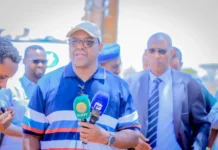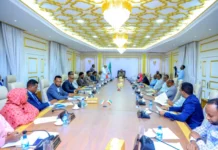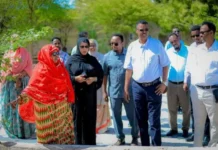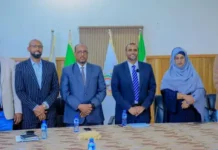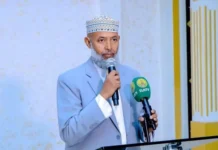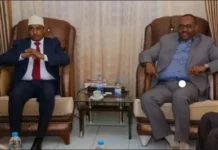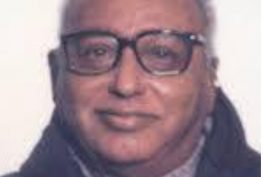Mogadishu: April 16 ,2019: The National Union of Somali Journalists (NUSOJ) mourns the loss of veteran journalist Mohamed Mohamud Afrah, who passed away in Nairobi on Sunday evening April 14, 2019.
According to family members the Late Mohamed Mohamud Afrah was so sick in the recent days and his health condition was deteriorating day after before passing away on Monday morning. Afrah was the founder of Halgan weekly English newspaper in Mogadishu in 1970s and he was also one of the most famous Somali journalists in the Somali speaking society.
“On behalf of Somali Journalists, I send my deepest and heartfelt condolences to the families, friends and journalist colleagues of late Mohamed Mohamud Afrah and may he rest in peace and ask Allah to give him in hereafter life in his paradise” Mohamed Ibrahim Moalimuu Secretary General of National Union of Somali Journalists said.
“The National Union of Somali Journalists (NUSOJ) shares this sad feeling and loss to all Somali Journalists and the family’s members of late Mohamed Mohamud Afrah who was a role model to many Somali journalists and his death is a big blow to the Somali media in general.
Mohamed Roble Noor, who worked together with Afrah at Halgan weekly newspaper said Mr. Afrah was always a happy person who is committed of telling the stories of Somalia to the world as it is. He had a page called “FIDAY-NOTEBOOK”. His book TARGET BOOK: VILLA SOMALIA in 1991 attracted many readers
PROFILE:
Mohamoud M. Afrah was born in the Somali capital of Mogadishu in 1933 and was raised, educated and worked in his adopted country of Kenya. He worked for a local newspaper as a cub reporter in the coastal town of Mombasa, and took a journalistic course in what was then the Federal Republic of Germany and was the first African journalist to cross the Berlin Wall through the notorious Charlie Check Point at the height of the Cold War.
At a press conference upon his return to West Berlin, he was asked his impression about the wall that divides the German people. He said that the wall goes through the same building where Africa was divided during the scramble for Africa in 1882/4.
“My own country was then sub-divided. Fortunately, there is no wall dividing the Somali people,” he told the West German journalists.
Asked if he met Soviet soldiers during his three-day visit in east Berlin, “No, but I felt their presence. I was being shadowed everywhere by ghost-like people,” he calmly told the assembled journalists.
Two days later, he wrote a scathing article in the German mass circulation Bild Zeitung and gave half an hour interview to a West Berlin TV channel, highlighting life inside the Soviet-occupied east Berlin that earned him “The Key of the City” and a life time residence of the city from the Mayor of West Berlin.
Three years later, he returned to his native country to set up a popular English language weekly (HEEGAN) and doubled as Reuters news agency correspondent in Somalia for more than two decades. He fought tooth and nail against draconian censorship laws introduced by the military regime in 1982. His weekly Friday Notebook gave the military regime’s ideologue endless displeasure. However, General Barre, who knew MM Afrah personally, told them to bog off!
He was detained briefly by the dreaded NSS (the National Security Service), but was released after protracted pressures by Reuters in London, Amnesty International, the New York-based Committee to Protect Journalists (CPJ) and the Paris-based Reporters without Borders. He refused to sit on the fence and watch his country fall apart due to outlandish revolutionary directives called Decreto by a military despot.
Mr. Afrah was there when military dictator, Major-General Mohamed Siyad Barre came to power in a military coup in October 1969. He was there when General Barre was ousted by a ragtag militia youths in beach sandals. He was there when the young United Somali Congress rebels turned their guns on each other for the control of Mogadishu, the Somali capital. He was there when US Marines and Army Rangers stormed the sandy beaches of the embattled capital to spearhead an international task force under orders from former US president George Bush, codenamed Operation Restore Hope. He was there to see them leave. He watched as their initial goodwill turn into an impotent rage, and saw their efforts to protect food aid end in fiasco. It cost the US and the United Nations billions of Dollars and the lives of several US and UN soldiers end up in body bags.
The cost to Mr. Afrah was the loss of one of his sons and the destruction of his home-cum-office after it received a direct hit from a T55 tank shell. Armed militia loyal to one of Mogadishu’s warlords kidnapped him but he was able to escape at the height of heavy bombardment by scaling seven feet wall.
He was once the only journalist representing an international news organization who remained in the war-torn country. He received more than 20 death threats from the local warlords, because they were upset about his dispatches from Somalia. Undaunted, he continued to send stories of the carnage in Somalia until the last possible moment. He was Newsman of the Year 1995. He has written several books about the civil war and famine and contributes hard-hitting Talking Points and commentaries about the Somali warlords to this website and to international and community newspapers in Canada where he writes things that other people are afraid to write and calls a spade a spade. In an article in the British edition of ESQUIRE magazine of April 1995, Aidan Hartley, who worked with MM Afrah in Africa, describes his frontline reporting as BRAVERY UNDER FIRE. “…Throughout Somalia’s civil war, the period of the failed United Nations mission and following their withdrawal, journalists have been murdered, kidnapped and harassed by the clan militias. Their offices and vehicles have been attacked and their freedom of expression curtailed. The Somalis who stayed on in Mogadishu are brave men and women-but few are as prominent as in reputation as Mohamoud M. Afrah. He escaped death and imprisonment at the nick of time on an international Red Cross flight after ruthless warlords kept him in a dungeon.”
Aidan Hartley,
ESQUIRE Magazine (British edition)
April 1995
Another colleague from Australia wrote: “I found congenial colleague in M.M. Afrah, long time Reuters correspondent in the city, who had survived both the destruction of his own home and the personal tragedy of his son’s death, and continues to file stories to his Bureau in London throughout the civil war.
Mogadishu was a place of war. Foreign journalists who went there encountered dangers, and witnessed horror and were glad to get away. It takes much longer to understand what that suffering means. To Somali journalists, like Afrah, this was their life, their people.”
James Schofield,
Author of SILENT OVER AFRICA,
Stories of war and Genocide,
Sydney, Australia.
In Canada, where he became an active member of the Journalists-in-Exile (JEX), a chapter of the Canadian Committee for Free Expression (CJFE), formerly Canadian Committee to Protect Journalists (CPJ), Mr. Afrah continued to write a number of hard-hitting articles and letters in the Toronto Star in response to Immigration rulings to deport Somali refugees back to their war-torn country. At the conclusion of one of his letters to the editor, he wrote: “I would think how ironic that Canada have a Society for the Prevention of Cruelty to Animals but no such organization for Somali refugees. It seems the Canadians and their American cousins love their beloved pets.”
That particular letter had generated heated debate on the opinion column of The Star. As a result, Somali refugees who have been in legal limbo for years because they had no IDs to establish that they fled the civil unrest in Somalia, have been granted Permanent Residence Status and many became law abiding Canadian citizens able to visit or sponsor their loved ones at home.
End
NUSOJ


